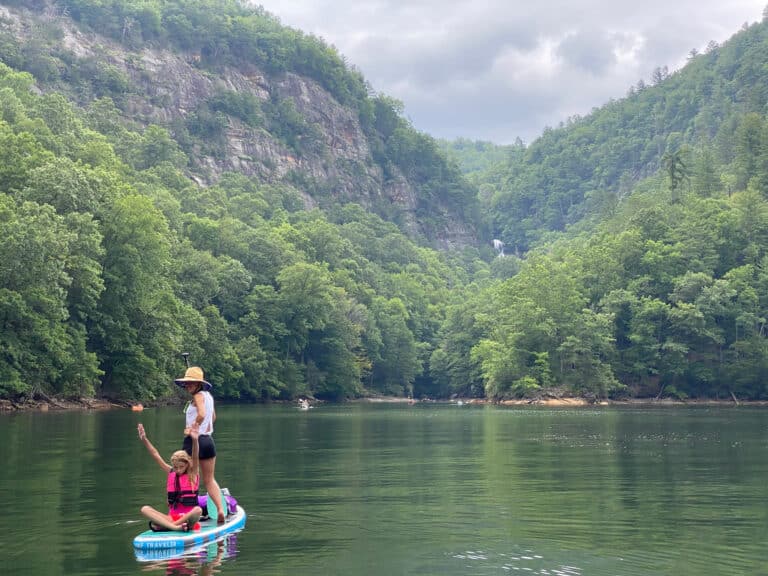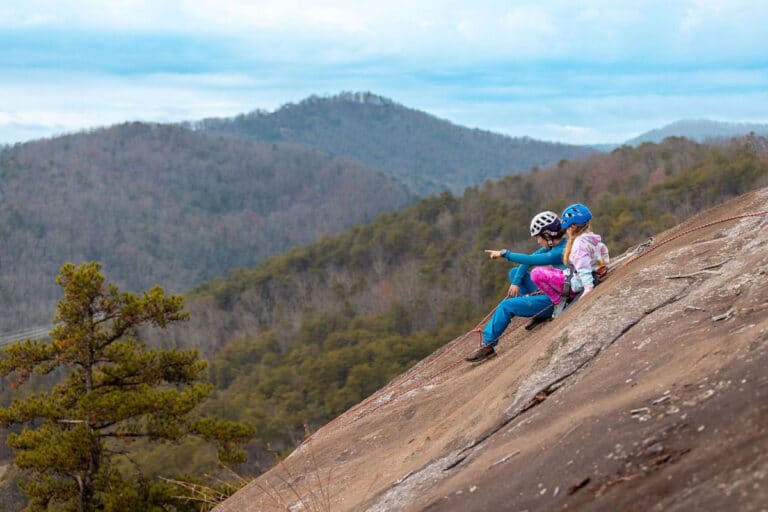The world of fly fishing is constantly evolving, and the characters who shape the sport have evolved right along with it. Many of today’s guides and gurus double as Instagram celebrities. Some have intertwined passions and hobbies like art and music into their love for catching fish on the fly, while others have used fly fishing as a way to meet and overcome what might have otherwise been insurmountable challenges.
I wanted to know more about the characters I was constantly seeing on my fly fishing heavy Instagram and Facebook news feeds, so I dug a little deeper. I happened upon a Virginia-native with one arm who ties flies and wrangles trout better than most anglers with two, a fly fishing tattoo artist out of West Asheville, and a classically trained bluegrass musician who can wield a fly rod and an upright bass with equal precision.
Get to know some of the most interesting and eclectic characters in the Blue Ridge fly fishing scene.
Josh Williams
Franklin County, Va.
Josh Williams is an Iraq war vet who lost his left arm in a motorcycle accident while driving to guard duty in Ft. Hood, Texas. The accident was life changing, but Josh didn’t let it slow him down. He discovered fly fishing during his long road to recovery and took to the sport with gusto. Because of his injury he fights fish by stripping line in with the aid of his teeth. Soon after adopting the sport he began tying his own flies and got so good at it that Orvis started selling two of his signature patterns— Josh’s White Lightning and Josh’s Wiggle Hellgrammite. These days the Franklin County, Va., native owns a company called Dead-Drift Flies which specializes in hand tied flies, guiding, and fly fishing-themed apparel.
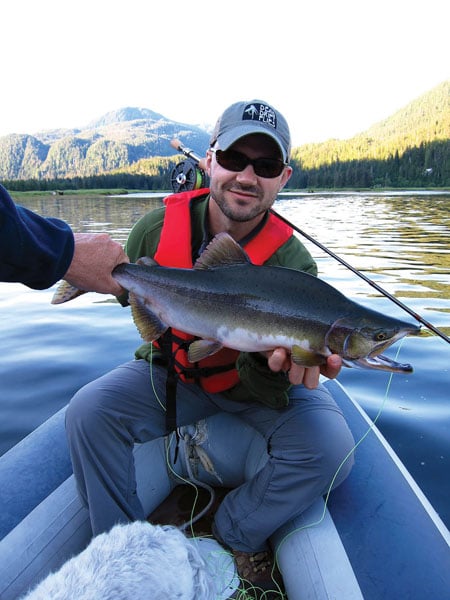
What drew you to the sport of fly fishing?
I’ve always found peace and excitement while fishing, and fly fishing brought that to a new level, especially the peace aspect after deployment and later losing my left arm. I feel a sense of accomplishment when I’m holding a fish with just one arm, and I love the comradery I’ve found in the fly fishing community.
Favorite fish to catch on the fly?
My absolute favorite is the brook trout. But in the summer, my heart belongs to smalljaws.
Favorite regional fishing spot?
That’s a hard one. I love several of the places within an hour of me. You’ve got the James and the New River and dozens of wild rainbow and native brook trout streams. Botetourt County offers a really cool hike stream with nice waterfalls called Roaring Run. Giles County has Little Stony Creek, which has a 69-foot waterfall. Both streams have a healthy supply of wild rainbows and native brookies. There are more, but you gotta get in my truck with a blindfold.
Most important lesson you’ve learned on the water?
The best lesson I’ve learned about fishing in the area was learned as a kid growing up in the region. Slow down. This becomes so important when brook trout fishing. Take a few minutes to observe the scene before stepping up to the water. You’ll see hidden trout, feeding behavior, and insect activity. And by going smooth and steady, you cover those spots that you’d swear have no fish yet somehow deliver a hidden gem.
Most memorable fly fishing moment?
I’ve had some pretty funny fails and some amazing opportunities to fish for amazing fish. But the craziest thing happened when I was in Alaska in 2014. After netting multiple pink salmon, my rod snapped at the second section. A buddy convinced me to try casting it with just the tip section (since I don’t need a reel so much with my teeth retrieval). I tried, and actually produced a nice cast. One nice enough to hook up on a pink. The story, as well as YouTube link, can be found at http://deaddriftva.com/fishing/healing-towers-day-7.
What are the two most important flies in your fly box?
Wooly bugger for warmwater fish, and an elk hair caddis for coldwater trout. I’ve caught more fish on those patterns than any other.
Danny Reed
Asheville, N.C.
Danny Reed is the co-founder of Crooked Creek Holler, a unique apparel company that started with just a sticker and a T-shirt. When he’s not fly fishing or working on his newly developed company, he can usually be found at Hot Stuff Tattoo shop in West Asheville where he’s one of the head artists. Whether he’s in the tattoo parlor or working out new designs for Crooked Creek Holler, much of Danny’s art begins with a real life fly fishing adventure. “I only create designs based on fish I’ve caught or animals I’ve hunted,” Danny says. “It all tells a story. As the company grows, I grow as an outdoorsman. New fish, new art, new gear and new experiences.”
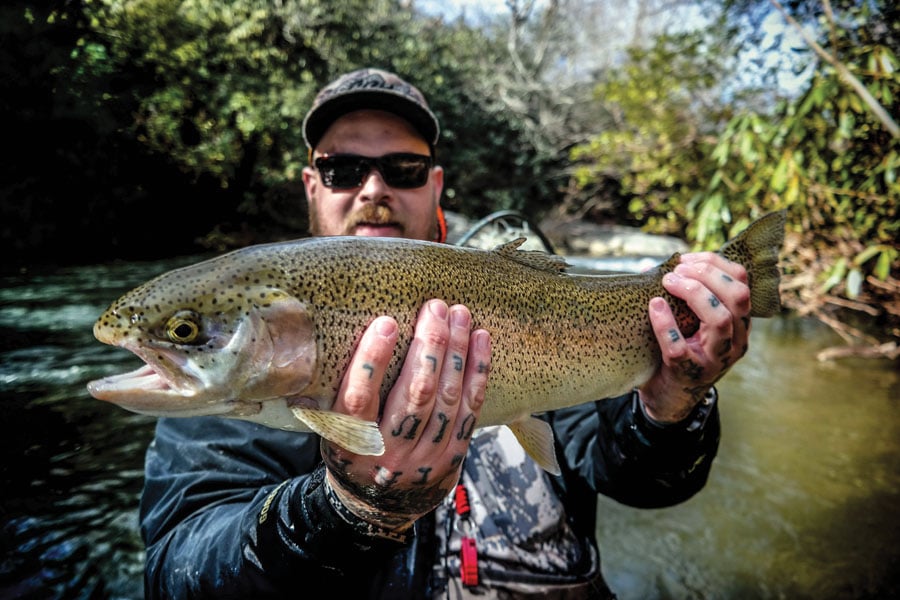
How’d you get into fly fishing? What is it that drew you to the sport?
I think what drew me more to fly fishing than anything else was the ability to escape from work and day to day activities, and actually get outside. I’ve lived in the Asheville area since 1999, and I felt like I really wasn’t utilizing all the great stuff this area has to offer.
Favorite fish to catch on the fly?
Definitely the smallmouth bass. They are aggressive and put up an exciting fight, especially on a fly rod. I have a lot of respect for them as a species. They grow at a really slow pace. It’s awesome to land a big smallie, knowing that that fish is pushing 15-20 years in age.
Favorite regional fishing spot?
I’d say most of my favorite regional spots are in east Tennessee. Lots of good bass and trout fishing goes on in that area.
Best piece of advice or lesson you’ve learned about fishing in the Blue Ridge?
The best lesson I’ve learned about fly fishing is to focus less on catching giant fish and more on being happy that you’re on the water and not at work. Don’t get me wrong, catching big fish is awesome, but it’s important not to lose sight of what it’s actually all about—being outside and taking a break from reality.
Most memorable fly fishing moment?
My most memorable fishing moment is hard to pin down. I’ve had some amazing times all over the country. Catching a big brown on the South Holston can be pretty unforgettable. I was just recently on Beaver Island in Michigan, and I caught some awesome carp, smallmouth and pike, but I’d have to say I’m most excited about heading to Brazil in October to chase peacock bass.
If you had to fish with one fly for the rest of your life what would it be?
This is a toss up between a Clouser or a Girdle Bug or a Pat’s Rubber Legs. Clouser’s are great for freshwater and salt and most fish will eat them, but I’ve caught a ton of different species on a girdle bug. Trout, bass, carp, bluegill, you name it. Freshwater fish love those things!
Tom Sadler
Harrisonburg, Va.
Tom Sadler found his way to a fly fishing career by way of Washington, D.C. where he worked as a conservation lobbyist in his former life. When the strain of the D.C.’s cutthroat political climate became too much to bear, Tom left it all and headed for the Shenandoah Valley of Virginia to hone his fly fishing skills and share them with others. Today he is the executive director of the Outdoor Writers Association of America and the resident Tenkara guide at Mossy Creek Fly Fishing.
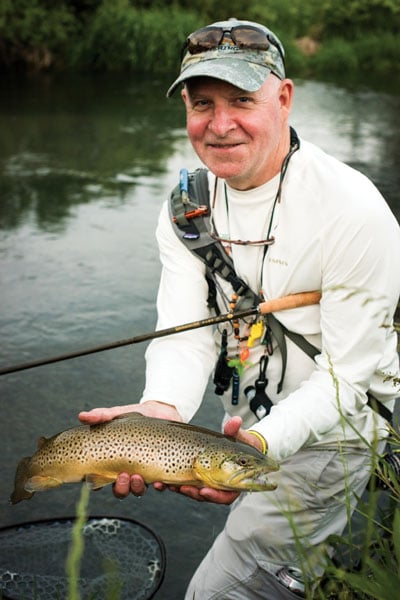
How long have you been fly fishing? Does iT run in your family?
My grandfathers, father, and stepfather were all fly fisherman so I learned from them. I started out trolling streamers on Moosehead Lake in Maine with a fly rod. As I got older, they taught me to cast a fly rod, and I’ve never used anything else.
Favorite fish to catch on the fly?
Brook trout are my favorite fish to catch on a fly. They are voracious, acrobatic and beautiful to look at when they come to hand.
Favorite regional fishing spot?
Here in Virginia, the Rapidan in the Shenandoah National Park, Dry River in the George Washington National Forest, and Mossy Creek in Augusta County.
Best piece of advice or lesson you’d give a newbie?
Learn to use a tenkara rod. Seriously, it is the most simple and effective way to fish mountain streams or spring creeks.
Most memorable fishing moment?
As a guide, the best memories come when clients catch fish they did not expect to catch. The smile on their faces and look of wonder in their eyes is memorable every time. It’s what makes guiding such a joy.
If you had to pick one fly TO fish with for the rest of you life, what would it be?
Olive Parachute Madam X.
George Daniel
State College, Penn.
George Daniel started fishing the mountain streams of Pennsylvania at age six. Since then he’s become a highly revered fly fishing expert, not only in the Blue Ridge but around the nation. He literally wrote the book on nymphing—Dynamic Nymphing— and has traveled to some of the world’s most renowned fishing holes with a fly rod in tow. Today he owns a company called Livin’ on the Fly, through which he offers specialized instruction and guided trips in the Pennsylvania limestone country.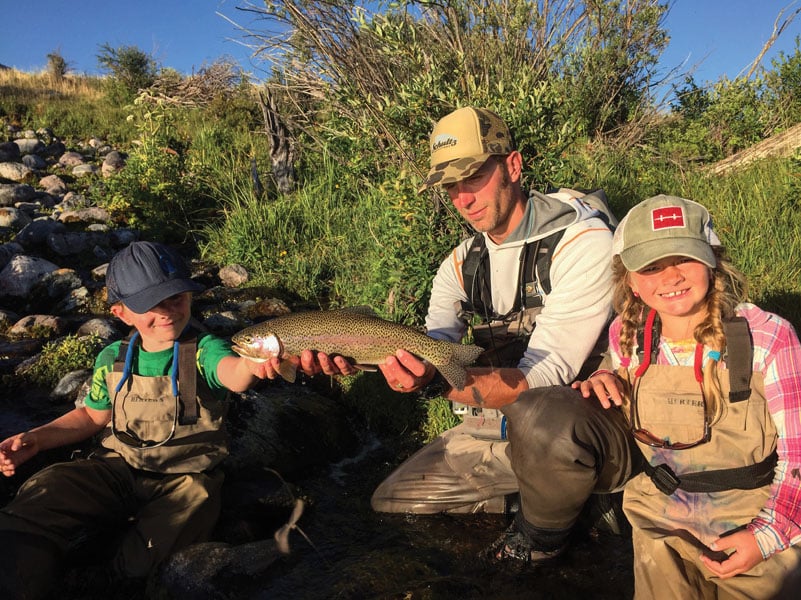 You’ve been fly fishing for most of your life. Tell us about the journey that brought you to where you are today.
You’ve been fly fishing for most of your life. Tell us about the journey that brought you to where you are today.
I grew up in Germania, a small village in northern Pennsylvania along the New York and Pennsylvania border. We were a one car family and my father was usually working, and there was this small stream called Germania Branch that flowed past our house. It was a kid’s only section and I was the only kid in the village that fished, so I had my own private brook trout fishery all to myself from age 6 to 14.
Do you have a favorite species?
While I’m starting to target other species, trout are far and away my favorite. I love the places trout fishing has taken me—everywhere from the mountain streams of Pennsylvania to the Alps of Italy and spring creeks in Portugal, to the western United State and all the way to New Zealand. As much as everyone wants to compare the similarity of streams, the truth is no two streams are identical. Every stream contains its own unique set of problems to solve.
Do you have a favorite regional fishing spot you’d be willing to share?
Central Pennsylvania. Maybe because it’s my home and where I’ve had so many fond experiences. Also, fish in that region do not give themselves up easily. I like a challenge, and my home waters offer me exactly what most anglers need on a regular basis—a big piece of humble pie.
Best piece of advice or lesson you’ve learned about fishing in the region?
Don’t give up on a spot after several casts. Our streams have excellent trout populations, but they demand good presentation. This means you must constantly change the weight of your nymphing rig or alter the size of your dry fly. Don’t give up on a good spot. While this advice applies to all waters, it rings particularly true in the Central Pennsylvania region.
Let’s hear your best fish story.
It was the day both of my children caught their first trout on the fly. Just seeing the wonder and excitement in their eyes takes me back to the strong emotional connection I had with trout growing up. While I continue to travel the country and the globe, that moment of watching both my children catch their fish will always be a favorite.
If you had to pick one fly TO fish with for the rest of you life, what would it be?
“The tug is the drug” is a favorite comment of streamer anglers. I have to admit, I’m addicted to streamer fishing so I’m going with a size 6 sparkle minnow streamer pattern.
Saravanan ‘Sav’ Sankaran
Asheville, N.C.
Sav is the fishing manager at Orvis Asheville, where he spends much of his time providing customers with valuable tips about the fly fishing mecca that is Western North Carolina. When he’s not geeking out on trout, he’s honing his impressive musical skills, a repertoire that includes proficiency in the arts of singing, banjo playing, guitar picking and stand up bass. In fact, he is one of the most in-demand stand up bassists in Western North Carolina’s rich bluegrass scene, and he’s toured with such artists as The Jon Stickley Trio and The Dixie Bee-Liners. Here’s more about Sav and his lifelong fly fishing obsession in his own words.
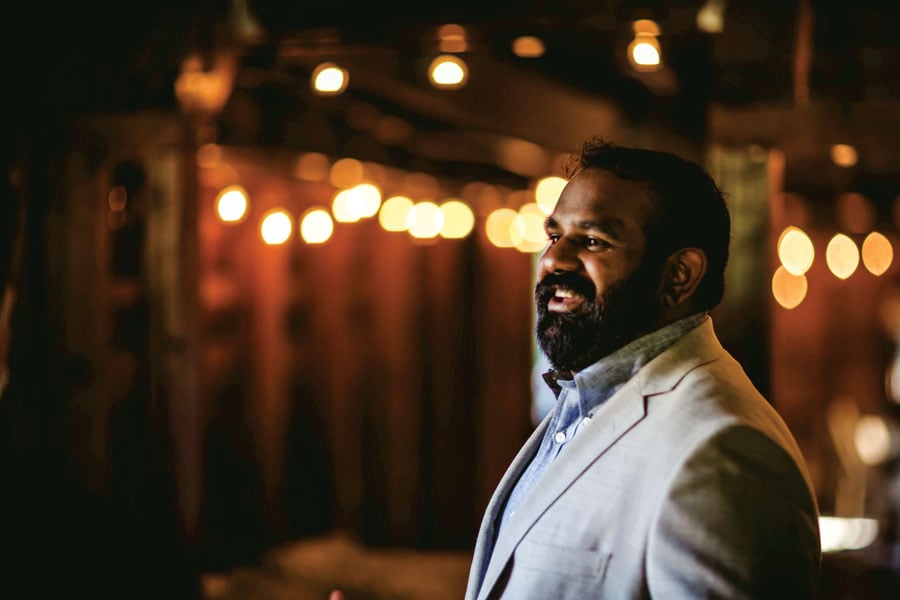
How’d you get into fly fishing?
Growing up in rural central Pennsylvania, I was introduced to the sport early on, being that the area is home to many miles of famed trout water, and fly fishing is a common pastime.
What is it that drew you to the sport?
I love the challenge of fly casting, as well as the opportunity the sport presents to learn more about various ecosystems, entomology, hydrology, and more. Fly fishing provides me with a framework to explore and experience my surroundings in a new and novel way.
Favorite fish to catch on the fly?
I have a soft spot for brook trout, particularly those found in our Southern Appalachian mountain streams. There’s something special about catching a native species in a setting that they have inhabited since the last Ice Age. They will take a well-presented fly readily, and their habitat is often beautiful and remote, all of which makes them my favorite species to chase with the fly rod.
Do you have A favorite regional fishing spot?
With so much amazing water within a short drive of Asheville, it’s tough to pick just one! In my opinion, the gem of Western North Carolina’s abundant resources is the plethora of “blue lines” that beckon any angler who looks at the map! Our many wild trout streams are my favorite place to spend some time on the water.
Best piece of advice or lesson you’ve learned about fishing in the region?
The most important lesson I’ve learned is that when it comes to becoming a better angler, there is no substitute to time spent on the water. To genuinely know an ecosystem as diverse and challenging as western N.C., you simply have to put the time in on the water.
What’s your favorite thing about working in the fly fishing industry?
My work at Orvis Asheville gives me the opportunity to interact with a lot of folks who are passionate about fly fishing. The most indelible of those moments is to see a beginning fly fisher get excited about the sport! Being in a position to pass on a love for the outdoors is extremely rewarding.
If you could only tie and use one fly for the rest of your fly fishing days what would it be?
Parachute Adams. It’s such a versatile fly pattern that is suggestive of a large group of food sources, and can be used just about anywhere!
